
Sydney Royal Easter Show
Encyclopedia
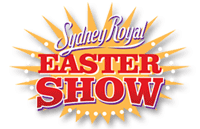
Sydney
Sydney is the most populous city in Australia and the state capital of New South Wales. Sydney is located on Australia's south-east coast of the Tasman Sea. As of June 2010, the greater metropolitan area had an approximate population of 4.6 million people...
, Australia over two weeks around Easter
Easter
Easter is the central feast in the Christian liturgical year. According to the Canonical gospels, Jesus rose from the dead on the third day after his crucifixion. His resurrection is celebrated on Easter Day or Easter Sunday...
.
It is run by the Royal Agricultural Society of New South Wales
Royal Agricultural Society of New South Wales
The Royal Agricultural Society of New South Wales is an Agricultural society based in New South Wales, Australia. They run many of the agricultural shows around New South Wales including the Sydney Royal Easter Show....
and was first held in 1823. Queen Victoria
Victoria of the United Kingdom
Victoria was the monarch of the United Kingdom of Great Britain and Ireland from 20 June 1837 until her death. From 1 May 1876, she used the additional title of Empress of India....
, (1837–1901), awarded the society and its show the right to use the word "Royal" in its name.
The Show is historically an event where "city meets country" and the rural industries of Australia can be shown and celebrated once a year.
The Show comprises an agricultural show
Agricultural show
An agricultural show is a public event showcasing the equipment, animals, sports and recreation associated with agriculture and animal husbandry. The largest comprise a livestock show , a trade fair, competitions, and entertainment...
, an amusement park
Amusement park
thumb|Cinderella Castle in [[Magic Kingdom]], [[Disney World]]Amusement and theme parks are terms for a group of entertainment attractions and rides and other events in a location for the enjoyment of large numbers of people...
and a fair
Fair
A fair or fayre is a gathering of people to display or trade produce or other goods, to parade or display animals and often to enjoy associated carnival or funfair entertainment. It is normally of the essence of a fair that it is temporary; some last only an afternoon while others may ten weeks. ...
and combines the elements of each, showcasing the judging of livestock
Livestock
Livestock refers to one or more domesticated animals raised in an agricultural setting to produce commodities such as food, fiber and labor. The term "livestock" as used in this article does not include poultry or farmed fish; however the inclusion of these, especially poultry, within the meaning...
and produce
Produce
Produce is a generalized term for a group of farm-produced goods and, not limited to fruits and vegetables . More specifically, the term "produce" often implies that the products are fresh and generally in the same state as where they were harvested. In supermarkets the term is also used to refer...
. This comprehensive fair has many competitions including arts and crafts
Arts and crafts
Arts and crafts comprise a whole host of activities and hobbies that are related to making things with one's hands and skill. These can be sub-divided into handicrafts or "traditional crafts" and "the rest"...
, photography
Photography
Photography is the art, science and practice of creating durable images by recording light or other electromagnetic radiation, either electronically by means of an image sensor or chemically by means of a light-sensitive material such as photographic film...
and cookery, as well as tests of strength and skill such as wood chopping
Wood chopping
Woodchop or wood chopping is a sport that has been around for hundreds of years in several cultures. In wood chopping competitions, skilled contestants attempt to be the first to cut or saw through a log or other block of wood...
. The Show also has shopping, restaurants, commercial stands and exhibits, a horticultural display, a national accredited conformation dog show and cat show
Cat show
A cat show is a judged event where the owners of cats compete to win titles in various cat registering organizations by entering their cats to be judged after a breed standard. Both pedigreed and companion cats are admissible, although the rules differ from organization to organization...
, and stage
Stage (theatre)
In theatre or performance arts, the stage is a designated space for the performance productions. The stage serves as a space for actors or performers and a focal point for the members of the audience...
and arena
Arena
An arena is an enclosed area, often circular or oval-shaped, designed to showcase theater, musical performances, or sporting events. It is composed of a large open space surrounded on most or all sides by tiered seating for spectators. The key feature of an arena is that the event space is the...
shows. The Show currently attracts one million people per year.
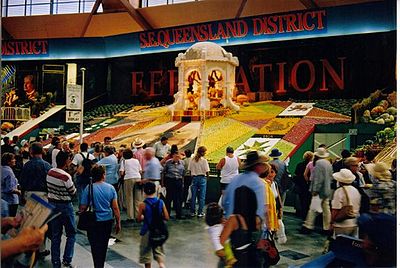
History
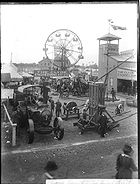
Parramatta, New South Wales
Parramatta is a suburb of Sydney, in the state of New South Wales, Australia. It is located in Greater Western Sydney west of the Sydney central business district on the banks of the Parramatta River. Parramatta is the administrative seat of the Local Government Area of the City of Parramatta...
, 24 kilometres west of the town of Sydney
Sydney
Sydney is the most populous city in Australia and the state capital of New South Wales. Sydney is located on Australia's south-east coast of the Tasman Sea. As of June 2010, the greater metropolitan area had an approximate population of 4.6 million people...
, and the display included horses, cattle, sheep, pigs and poultry.
In 1869, the venue was moved from Parramatta to Prince Alfred Park until 1881 when the Government of New South Wales
Government of New South Wales
The form of the Government of New South Wales is prescribed in its Constitution, which dates from 1856, although it has been amended many times since then...
provided land for the Royal Agricultural Society at Moore Park
Moore Park, New South Wales
Moore Park is a large area of parkland in the Eastern Suburbs of Sydney, in the state of New South Wales, Australia. It is part of Centennial Parklands, a collective of three parks being Moore Park, Centennial Park and Queens Park. Centennial Parklands is administered by the Centennial Park &...
where the show was held for 116 years. In 1998, the Show moved to a new showground in Sydney Olympic Park
Sydney Olympic Park
Sydney Olympic Park is a suburb in western Sydney, in the state of New South Wales, Australia. Sydney Olympic Park is located 16 kilometres west of the Sydney central business district, in the local government area of Auburn Council....
at Homebush Bay
Homebush Bay, New South Wales
Homebush Bay was the former name of a suburb of western Sydney, in the state of New South Wales, Australia that took in the suburbs of Sydney Olympic Park, Wentworth Point and part of the neighbouring suburb of Lidcombe. Homebush Bay is located 16 kilometres west of the Sydney central business...
. The former Sydney Showground
Sydney Showground (Moore Park)
The former Sydney Showground at Moore Park was the site of the Sydney Royal Easter Show in New South Wales, Australia from 1882 until 1997, when the Show was moved to the new Sydney Showground at Homebush Bay, which was built for the Sydney 2000 Olympics...
at Moore Park has since been converted into Fox Studios Australia
Fox Studios Australia
Fox Studios Australia is a major movie studio located in Sydney, Australia, occupying the site of the former Sydney Showground at Moore Park...
with associated development known as The Entertainment Quarter
The Entertainment Quarter
The Entertainment Quarter is an entertainment precinct in the Eastern Suburbs of Sydney, Australia. The Entertainment Quarter sits beside Fox Studios Australia in the suburb of Moore Park, located 3 kilometres south-east of the Sydney central business district and is part of local government area...
.
The Show has been held every year since 1869 except during the severe outbreak of the Spanish flu
Spanish flu
The 1918 flu pandemic was an influenza pandemic, and the first of the two pandemics involving H1N1 influenza virus . It was an unusually severe and deadly pandemic that spread across the world. Historical and epidemiological data are inadequate to identify the geographic origin...
in 1919 and between the years of 1942 and 1946 when it was interrupted by World War II
World War II
World War II, or the Second World War , was a global conflict lasting from 1939 to 1945, involving most of the world's nations—including all of the great powers—eventually forming two opposing military alliances: the Allies and the Axis...
. Traditionally, the Show began on the Friday before Easter, was closed on Sundays and Good Friday
Good Friday
Good Friday , is a religious holiday observed primarily by Christians commemorating the crucifixion of Jesus Christ and his death at Calvary. The holiday is observed during Holy Week as part of the Paschal Triduum on the Friday preceding Easter Sunday, and may coincide with the Jewish observance of...
and packed up the Tuesday following Easter, the Tuesday being "Children's Day" when goods such as showbag
Showbag
The showbag is a themed bag of commercial merchandise, and a distinctive feature of Australian shows...
s were reduced in price.

Yielding to pressure from the public, the Show was later to be opened on Sundays and Good Friday. With the move to Homebush Bay, the Show was extended to two weeks. In 2007, a revised program took into account changes to NSW School Holidays, the Show commencing on the Thursday before Good Friday in order to increase the holiday time for families to attend.
Overview
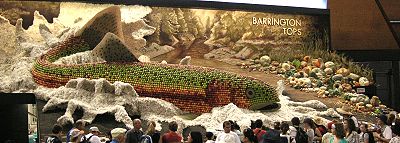
Horticulture
The first purpose of the Show is specifically to encourage agriculture. Although other aspects of the show have developed including competitions, entertainment and commerce, the display of the products of rural industry remain of major importance, the RAS claiming 30,000 rural exhibits in 2007.One of the most popular sights at the show is the "District Exhibits" competition. These displays are set up by four districts of NSW and South East Queensland. A theme is selected and created pictorially on a large scale, to strict rules and using only the produce of the particular district which typically includes wool, wheat, apples, pumpkins, sugar cane, citrus fruit, vegetables and brightly coloured bottles of preserves. Also displayed are other primary products such as fleeces, carcases of beef, wine, honey, cheese and sausages. There is also a flower show at which are judged both horticultural specimens and floral displays.

Livestock
During the course of the show, a large range of livestock is judged. This includes the famous MerinoMerino
The Merino is an economically influential breed of sheep prized for its wool. Merinos are regarded as having some of the finest and softest wool of any sheep...
sheep, whose fine wool was a major source of Australia's wealth in the 19th and 20th centuries. Also shown are dairy cattle of which the major breeds are the Australian Illawarra Shorthorn, Friesian
Holstein (cattle)
Holstein cattle is a breed of cattle known today as the world's highest production dairy animal. Originating in Europe, Holsteins were bred in what is now the Netherlands and more specifically in the two northern provinces of North Holland and Friesland...
, Ayrshire
Ayrshire
Ayrshire is a registration county, and former administrative county in south-west Scotland, United Kingdom, located on the shores of the Firth of Clyde. Its principal towns include Ayr, Kilmarnock and Irvine. The town of Troon on the coast has hosted the British Open Golf Championship twice in the...
, Jersey
Jersey
Jersey, officially the Bailiwick of Jersey is a British Crown Dependency off the coast of Normandy, France. As well as the island of Jersey itself, the bailiwick includes two groups of small islands that are no longer permanently inhabited, the Minquiers and Écréhous, and the Pierres de Lecq and...
and Guernsey
Guernsey
Guernsey, officially the Bailiwick of Guernsey is a British Crown dependency in the English Channel off the coast of Normandy.The Bailiwick, as a governing entity, embraces not only all 10 parishes on the Island of Guernsey, but also the islands of Herm, Jethou, Burhou, and Lihou and their islet...
. Beef cattle are predominantly Hereford
Hereford
Hereford is a cathedral city, civil parish and county town of Herefordshire, England. It lies on the River Wye, approximately east of the border with Wales, southwest of Worcester, and northwest of Gloucester...
, Aberdeen Angus and Murray Grey
Murray Grey
Murray Grey is a breed of Australian polled beef cattle that was developed in the upper Murray River valley on the New South Wales /Victorian border...
with other breeds including Brahman
Brahman
In Hinduism, Brahman is the one supreme, universal Spirit that is the origin and support of the phenomenal universe. Brahman is sometimes referred to as the Absolute or Godhead which is the Divine Ground of all being...
, Devon
Devon
Devon is a large county in southwestern England. The county is sometimes referred to as Devonshire, although the term is rarely used inside the county itself as the county has never been officially "shired", it often indicates a traditional or historical context.The county shares borders with...
and Charolais
Charolais cattle
Charolais cattle are a beef breed of cattle which originated in Charolais, around Charolles, in France. They are raised for their meat and are known for their composite qualities when crossed with other breeds, most notably Angus and Hereford cattle...
. Other livestock judged at the show include a variety of sheep, pigs, goats, alpacas and poultry of all sorts.
Horses

Australian Stock Horse
The Australian Stock Horse , has been especially bred for Australian conditions. It is a hardy breed of horse noted for endurance, agility and a good temperament. Its ancestry dates to the arrival of the first horses in Australia, brought from Europe, Africa and Asia...
s, Buckskins, Clydesdales, Hackneys, Miniature Horses, Australian National Saddlehorses, Palomino
Palomino
Palomino is a coat color in horses, consisting of a gold coat and white mane and tail. Genetically, the palomino color is created by a single allele of a dilution gene called the cream gene working on a "red" base coat...
s, Percheron
Percheron
The Percheron is a breed of draft horse that originated in the Perche valley in northern France. Percherons are usually gray or black in color. They are well-muscled, and known for their intelligence and willingness to work. Although their exact origins are unknown, the ancestors of the breed were...
s, Pintos, Shetland Ponies
Shetland pony
The Shetland pony is a breed of pony originating in the Shetland Isles. Shetlands range in size from a minimum height of approximately 28 inches to an official maximum height of 42 inches at the withers. Shetland ponies have heavy coats, short legs and are considered quite intelligent...
, Shire
Shire
A shire is a traditional term for a division of land, found in the United Kingdom and in Australia. In parts of Australia, a shire is an administrative unit, but it is not synonymous with "county" there, which is a land registration unit. Individually, or as a suffix in Scotland and in the far...
s, and Warmblood
Warmblood
Warmbloods are a group of middle-weight horse types and breeds, primarily originating in Europe, registered with organizations that are characterized by open studbook policy, studbook selection, and the aim of breeding for equestrian sport...
s etc. A large section of the ridden classes are pony
Pony
A pony is a small horse . Depending on context, a pony may be a horse that is under an approximate or exact height at the withers, or a small horse with a specific conformation and temperament. There are many different breeds...
, galloway and hack height classes, and the "Sydney Royal" is considered one of the hardest and most prestigious shows in Australia. A popular sight in the arena is the Carlton & United Brewery wagon, drawn by the team of "Carlton Clydesdales".

Domestic animals
As part of the Royal Easter Show there is a Dog Show in which about 3,000 dogs are displayed and judged. There is also a Cat Show and competitions for caged birds, rabbits, mice and rats. There is a large pigeon show. Displays are given by working dogs, Australian Kelpie
Australian Kelpie
The Kelpie is an Australian sheep dog successful at mustering and droving with little or no command guidance. They are medium-sized dogs and come in a variety of colours...
s, Border Collie
Border Collie
The Border Collie is a herding dog breed developed in the Anglo-Scottish border region for herding livestock, especially sheep. It is the most widespread of the collie breeds....
s and Australian Cattle Dog
Australian Cattle Dog
The Australian Cattle Dog is a breed of herding dog originally developed in Australia for droving cattle over long distances across rough terrain. In the 19th century, New South Wales cattle farmer Thomas Hall crossed the dogs used by drovers in his parents' home county, Northumberland, with...
s.
Animal Nursery


Rural competitions
"The Woodchop" is one of the most popular demonstrations and competitions, taking place in a purpose-built stadium. The timber used is Australian hardwood so the splinters really fly.Other popular events are the Tent Pegging
Tent pegging
Tent pegging is a cavalry sport of ancient origin, and is one of only ten equestrian disciplines officially recognised by the International Federation for Equestrian Sports. Used narrowly, the term refers to a specific mounted game with ground targets...
and the Polocrosse
Polocrosse
Polocrosse it is a team sport that is played all over the world. It is a combination of polo and lacrosse. It is played outside, on a field , on horseback. Each rider uses a cane stick to which is attached a racquet head with a loose, thread net, in which the ball is carried. The ball is made of...
with the NSW Mounted Police on their well-matched bay horses always competing. The Dressage
Dressage
Dressage is a competitive equestrian sport, defined by the International Equestrian Federation as "the highest expression of horse training." Competitions are held at all levels from amateur to the World Equestrian Games...
and Show Jumping
Show jumping
Show jumping, also known as "stadium jumping," "open jumping," or "jumpers," is a member of a family of English riding equestrian events that also includes dressage, eventing, hunters, and equitation. Jumping classes commonly are seen at horse shows throughout the world, including the Olympics...
are the culmination of Australia-wide gymkhanas held at the annual circuit of local agricultural shows, with successful competitors going on to Olympic competition. The equally demanding but less fastidious skills of buckjumping and steer-roping draw young men from across Australia and Northern America to compete in the Rodeo
Rodeo
Rodeo is a competitive sport which arose out of the working practices of cattle herding in Spain, Mexico, and later the United States, Canada, South America and Australia. It was based on the skills required of the working vaqueros and later, cowboys, in what today is the western United States,...
.
Arts and Crafts
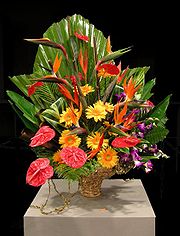
Scone (bread)
The scone is a small Scottish quick bread especially popular in the United Kingdom, the United States, Canada, Australia, New Zealand,Belgium and Ireland, but are also eaten in many other countries. They are usually made of wheat, barley or oatmeal, with baking powder as a leavening agent...
, fruitcake
Fruitcake
Fruitcake is a cake made with chopped candied fruit and/or dried fruit, nuts, and spices, and soaked in spirits. A cake that simply has fruit in it as an ingredient can also be colloquially called a fruitcake. In the United Kingdom, certain rich versions may be iced and decorated...
and preserves. Crafts have traditionally included three crochet
Crochet
Crochet is a process of creating fabric from yarn, thread, or other material strands using a crochet hook. The word is derived from the French word "crochet", meaning hook. Hooks can be made of materials such as metals, woods or plastic and are commercially manufactured as well as produced by...
ted doilies, a smocked
Smocking
Smocking is an embroidery technique used to gather fabric so that it can stretch. Before elastic, smocking was commonly used in cuffs, bodices, and necklines in garments where buttons were undesirable. Smocking developed in England and has been practised since the Middle Ages and is unusual among...
baby's dress and a man's knitted
Knitting
Knitting is a method by which thread or yarn may be turned into cloth or other fine crafts. Knitted fabric consists of consecutive rows of loops, called stitches. As each row progresses, a new loop is pulled through an existing loop. The active stitches are held on a needle until another loop can...
sleeveless sweater
Sweater
A sweater, jumper, pullover, sweatshirt, jersey or guernsey is a garment intended to cover the torso and arms. It is often worn over a shirt, blouse, T-shirt, or other top, but may also be worn alone as a top...
. Over 100 years the classes have been expanded to include a vast range of cooking and crafts in which men may also compete. Among the crafts are the spinning
Spinning (textiles)
Spinning is a major industry. It is part of the textile manufacturing process where three types of fibre are converted into yarn, then fabric, then textiles. The textiles are then fabricated into clothes or other artifacts. There are three industrial processes available to spin yarn, and a...
, weaving
Weaving
Weaving is a method of fabric production in which two distinct sets of yarns or threads are interlaced at right angles to form a fabric or cloth. The other methods are knitting, lace making and felting. The longitudinal threads are called the warp and the lateral threads are the weft or filling...
and dyeing
Dyeing
Dyeing is the process of adding color to textile products like fibers, yarns, and fabrics. Dyeing is normally done in a special solution containing dyes and particular chemical material. After dyeing, dye molecules have uncut Chemical bond with fiber molecules. The temperature and time controlling...
of wool, woodwork, leather
Leather
Leather is a durable and flexible material created via the tanning of putrescible animal rawhide and skin, primarily cattlehide. It can be produced through different manufacturing processes, ranging from cottage industry to heavy industry.-Forms:...
work, enamelling, lace
Lace
Lace is an openwork fabric, patterned with open holes in the work, made by machine or by hand. The holes can be formed via removal of threads or cloth from a previously woven fabric, but more often open spaces are created as part of the lace fabric. Lace-making is an ancient craft. True lace was...
making, embroidery
Embroidery
Embroidery is the art or handicraft of decorating fabric or other materials with needle and thread or yarn. Embroidery may also incorporate other materials such as metal strips, pearls, beads, quills, and sequins....
, toymaking and patchwork
Patchwork
Patchwork or "pieced work" is a form of needlework that involves sewing together pieces of fabric into a larger design. The larger design is usually based on repeat patterns built up with different colored shapes. These shapes are carefully measured and cut, straight-sided, basic geometric shapes...
.
The various fashions in craft have changed dramatically over the years and these changes are reflected in the number of exhibits and in the classes. From 1960 until about 1990 one of the most popular crafts was cake decorating
Wedding cake
A wedding cake is the traditional cake served to the guests at a wedding reception after a wedding. In modern Western culture, it is usually a large cake, multi-layered or tiered, and heavily decorated with icing, usually over a layer of marzipan or fondant...
, with numerous expert decorators vying for fineness in their "extension work" and creating designs of extraordinary delicacy and intricacy. In the 21st century these technical skills have almost disappeared. On the other hand, the art of paper tole, also requiring of much fine control, has become a popular craft, as witnessed by the large number of entries to the competition.
Associated with the Show, and displayed in the same pavilion as the craft competitions is an Art Show with classes for Rural subjects, Still Life
Still life
A still life is a work of art depicting mostly inanimate subject matter, typically commonplace objects which may be either natural or man-made...
, Watercolour and Figurative painting. There are competitions for sculpture
Sculpture
Sculpture is three-dimensional artwork created by shaping or combining hard materials—typically stone such as marble—or metal, glass, or wood. Softer materials can also be used, such as clay, textiles, plastics, polymers and softer metals...
, photography
Photography
Photography is the art, science and practice of creating durable images by recording light or other electromagnetic radiation, either electronically by means of an image sensor or chemically by means of a light-sensitive material such as photographic film...
, silver
Silver
Silver is a metallic chemical element with the chemical symbol Ag and atomic number 47. A soft, white, lustrous transition metal, it has the highest electrical conductivity of any element and the highest thermal conductivity of any metal...
work and ceramics
Ceramic art
In art history, ceramics and ceramic art mean art objects such as figures, tiles, and tableware made from clay and other raw materials by the process of pottery. Some ceramic products are regarded as fine art, while others are regarded as decorative, industrial or applied art objects, or as...
.
Government displays
The State and Federal Governments both contribute exhibitions to the show though their presence has diminished significantly since the relocation to Homebush Bay in 1998. Many government departments such as NSW Lotteries, Cityrail and NSW Health have axed their annual displays. However bodies such as The Rural Fire Service, the NSW Police, the Ambulance Service, the Army Reserve continue to set up displays to inform and promote goodwill to the public.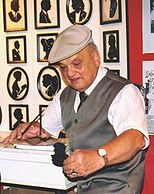
Services
Foremost among the charitable bodies and service organisations with an active presence at the Show are the St. John Ambulance Australia who not only provided on the spot attention for sunstroke but also injuries sustained while steer-roping.Providing sustenance of another sort is the Country Women's Association
Country Women's Association
The Country Women’s Association of Australia is the largest women's organisation in Australia. It has 44,000 members across 1855 branches. Its aims are to improve the conditions for country women and children and to try to make life better for women and their families, especially those women...
or CWA who have a prominently placed cafe selling Devonshire Teas and other goodies.
Commercial
An important tradition of the Royal Easter Show since 1900 is the selling of merchandises known as showbagShowbag
The showbag is a themed bag of commercial merchandise, and a distinctive feature of Australian shows...
s. Originally called 'Sample Bags' (and free), they were a means for manufacturers to market their products to the general public, today showbags often come in the form of promotional merchandises, as well as toy
Toy
A toy is any object that can be used for play. Toys are associated commonly with children and pets. Playing with toys is often thought to be an enjoyable means of training the young for life in human society. Different materials are used to make toys enjoyable and cuddly to both young and old...
s targeting children.
Apart from Showbag Hall there are many other commercial enterprises who are "stall holders" at the Royal Easter Show. These range from international companies providing finance and agricultural plant
Plant
Plants are living organisms belonging to the kingdom Plantae. Precise definitions of the kingdom vary, but as the term is used here, plants include familiar organisms such as trees, flowers, herbs, bushes, grasses, vines, ferns, mosses, and green algae. The group is also called green plants or...
to purveyors of fairground ephemera
Ephemera
Ephemera are transitory written and printed matter not intended to be retained or preserved. The word derives from the Greek, meaning things lasting no more than a day. Some collectible ephemera are advertising trade cards, airsickness bags, bookmarks, catalogues, greeting cards, letters,...
, fairy floss and meat pie
Meat pie
A meat pie is a savoury pie with a filling of meat and other savoury ingredients. Principally popular in Europe, Australia and New Zealand, meat pies differ from a pasty in the sense that a pasty is typically a more portable, on-the-go item, as opposed to a more conventional pie.-History:The...
s. Many of the manufacturers represented are providing goods closely associated with rural industry such as work boots, woollen sweaters and the iconic Akubra
Akubra
Akubra is an Australian brand of bush hat, whose wide-brimmed styles are a distinctive part of Australian culture, especially in rural areas. The name is believed to be derived from an Aboriginal word for head covering....
hat and Driza-Bone
Driza-Bone
Driza-Bone, originating from the phrase "dry as a bone", is a trade name for the company making full-length waterproof riding coats and apparel. The company was established in 1898 and is currently Australian owned and manufactures its products in Australia...
raincoat. S. John Ross
S. John Ross (artist)
Sebastian John Ross, , known as S. John Ross or "The Silhouette Man", was an American-born Australian artist and showman, famous for his miniature silhouette portraits cut in black card. S...
, master of the silhouette, (pictured right) won the Legend Award at the 2007 Royal Easter Show. S. John Ross worked until his death at age 89.
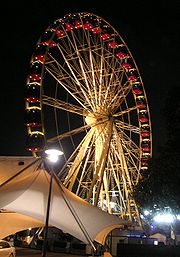
Entertainment
The Royal Easter Show has a sideshow alleySideshow alley
A sideshow alley is an Australian term for the cluster of attractions that may accompany public events such as agricultural shows. It is similar to the American term 'midway'...
along which are the amusement ride
Amusement ride
Amusement rides are large mechanical devices that move people to create enjoyment. They are frequently found at amusement parks, traveling carnivals, and funfairs.-Notable types:*Afterburner*Ali Baba*Balloon Race*Booster...
s, sideshow
Sideshow
In America, a sideshow is an extra, secondary production associated with a circus, carnival, fair or other such attraction.- Types of attractions :There are four main types of classic sideshow attractions:...
s and competitive stands. The provided entertainment includes pop music
Pop music
Pop music is usually understood to be commercially recorded music, often oriented toward a youth market, usually consisting of relatively short, simple songs utilizing technological innovations to produce new variations on existing themes.- Definitions :David Hatch and Stephen Millward define pop...
concerts and, in 2007, a staged sideshow
Sideshow
In America, a sideshow is an extra, secondary production associated with a circus, carnival, fair or other such attraction.- Types of attractions :There are four main types of classic sideshow attractions:...
program has been introduced as well.
In 2009, the show debuted three new amusement rides, Pirate's Revenge(a Reverchon Log Flume), Buried Alive (a motion simulator simulating being buried alive) and the Haunted Hotel (Ghost Train). These join such traditional delights as Frank Laurie's Steam Merry-Go-Round, built in the 1890s and touring Australia for 80 years.
In the evening the NAB Arena becomes the venue for spectacular entertainment which regularly includes the NSW Mounted Police Musical Ride, the Precision Driving display, originally performed in Holden
Holden
GM Holden Ltd is an automaker that operates in Australia, based in Port Melbourne, Victoria. The company was founded in 1856 as a saddlery manufacturer. In 1908 it moved into the automotive field, before becoming a subsidiary of the U.S.-based General Motors in 1931...
s, but in recent years Toyotas . The entertainment culminates with fireworks
Fireworks
Fireworks are a class of explosive pyrotechnic devices used for aesthetic and entertainment purposes. The most common use of a firework is as part of a fireworks display. A fireworks event is a display of the effects produced by firework devices...
. The Australia versus New Zealand Rodeo Teams Challenge is also an exciting event with plenty of action.
Pricing

The 2007, pricing was even higher than 2006, with adults at A$ 31.00, with a discount of 10% ($27.90) if purchased online, children's tickets were A$ 21.50 or $19.30 with an online purchase, and concessions are $25.50 or $22.90 when bought online. The tickets in 2008 were $32 for adults, 25.50 for concessions. There was a "kids' day" on the last day with admission at for children at $10.
Tickets for the Show can be bought through Post Offices and at Railway Stations where the pass includes travel. In 2011 Showbag
Showbag
The showbag is a themed bag of commercial merchandise, and a distinctive feature of Australian shows...
s were priced from $1.00 to $25.00

